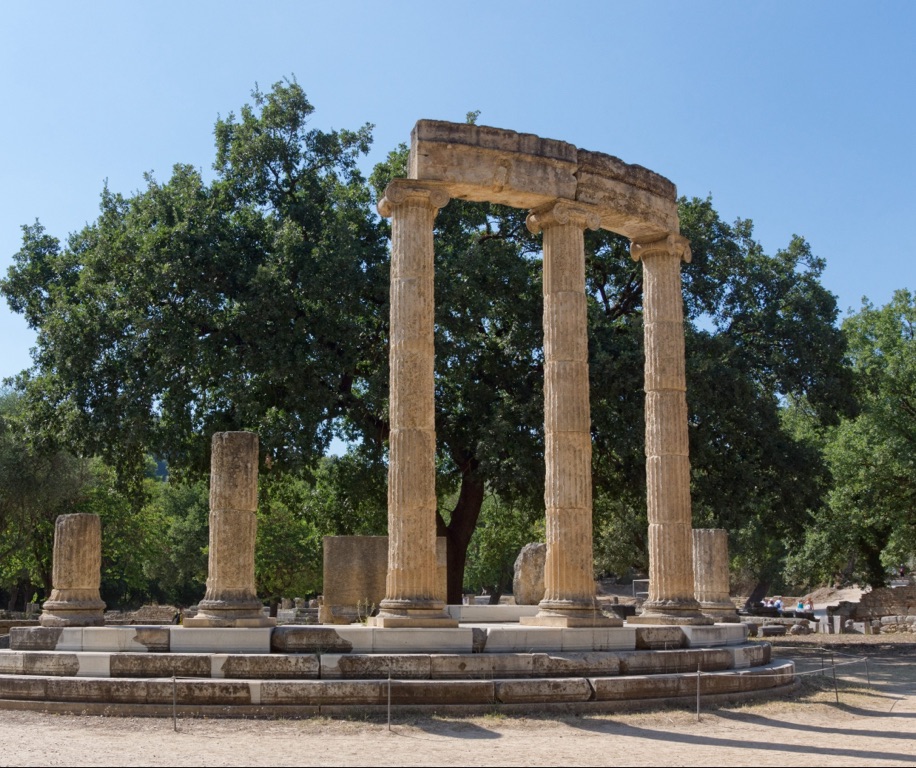The Philippeion in Olympia, Greece, stands as a remarkable structure from ancient times. It was a circular memorial of ivory and gold, built by Philip II of Macedon. The Philippeion celebrated the Macedonian dynasty, housing statues of Philip’s family. This unique structure is among the few examples of ancient Greek circular buildings. It reflects the grandeur of Macedon’s royal family and their influence on Greek culture and politics.
Get your dose of History via Email
Historical Background of the Philippeion
The Philippeion, nestled in the sanctuary of Olympia, was an offering from Philip II after his victory at the Battle of Chaeronea in 338 BC. This battle solidified Macedonian power over Greece. The structure was designed by the architect Leochares and was completed by Alexander the Great after Philip’s assassination. The discovery of the Philippeion dates back to the German Archaeological Institute’s excavations in the 20th century. The site has since provided insights into Macedonian influence on Greek sanctuaries.
Philip II’s intent was to commemorate his family in the religious heart of Greece. The Philippeion housed chryselephantine (gold and ivory) statues of Philip, his parents, his wife Olympias, and young Alexander. This act was a bold statement of power and divine association. The structure later saw renovations under the Romans but maintained its significance as a symbol of the Macedonian dynasty.
Throughout history, the Philippeion has witnessed various phases of occupation and reverence. It stood as a testament to the political and cultural shifts in ancient Greece. The site’s importance was not just in its construction but also in its strategic and symbolic placement within the sacred precinct of Olympia. It was a bold declaration of Macedonian ascendancy and divine favor.
The Philippeion’s historical significance extends beyond its physical presence. It marked a turning point in Greek history, where the traditional city-states began to decline as Macedonian power rose. The structure also symbolized a shift in religious practices, with the royal family being celebrated alongside the gods.
While the Philippeion was not the scene of historically important events like battles or political assemblies, its very existence influenced Greek culture. It represented the intersection of politics, religion, and art. The Philippeion remains a focal point for understanding the complexities of Macedonian and Greek interactions during a pivotal era.
About the Philippeion
The Philippeion, with its circular design, was a departure from the typical rectangular structures of the time. It was built from limestone and covered with fine stucco. The building featured an outer colonnade of Ionic columns and an inner cella with Corinthian columns. The roof was conical, adding to its grandeur and distinctiveness.
The interior of the Philippeion was as impressive as its exterior. The chryselephantine statues stood on a circular base, with the royal family depicted in a heroic manner. The use of gold and ivory in the statues was a display of wealth and artistic sophistication. These materials also had religious connotations, enhancing the sacred nature of the space.
The construction methods of the Philippeion were advanced for its time. The precise placement of columns and the use of entasis, a slight curvature in columns, showcased Greek architectural prowess. The building materials were sourced from nearby regions, demonstrating the interconnectedness of the ancient Greek world.
Architectural highlights of the Philippeion include the Ionic frieze that ran around the building’s exterior. This frieze depicted scenes from Greek mythology, further linking the royal family to the divine. The harmonious proportions of the structure adhered to the classical ideals of beauty and symmetry.
The Philippeion’s design and construction methods have influenced subsequent generations of architects. Its circular form inspired later structures, both in ancient times and in neoclassical architecture. The Philippeion stands as a testament to the ingenuity and artistry of ancient Greek builders.
Theories and Interpretations
The Philippeion has been subject to various theories and interpretations over the years. Its purpose, beyond being a memorial, is debated among historians. Some suggest it may have served as a meeting place for the League of Corinth, an alliance headed by Philip II.
The choice to depict the royal family in a sanctuary dedicated to the gods has led to theories about the divine status claimed by the Macedonian rulers. The presence of these statues in Olympia could indicate an attempt to link the dynasty to the divine pantheon of Greece.
There are mysteries surrounding the Philippeion, particularly regarding the original appearance of the statues and the exact rituals performed within its walls. The use of chryselephantine statues was rare and reserved for the most sacred spaces, hinting at the importance of the Philippeion.
Historical records and archaeological evidence have been matched to interpret the Philippeion’s role in ancient society. Inscriptions and ancient texts provide some context, but much is left to scholarly interpretation. The dating of the structure has been confirmed through stratigraphy and pottery found on-site.
The Philippeion’s construction during a time of political change in Greece has led to interpretations of its broader significance. It reflects the shift from polis to monarchy and the rise of personal cults around powerful leaders. The structure is a physical embodiment of these historical trends.
At a glance
Country: Greece
Civilization: Ancient Macedonia
Age: Constructed in 338 BC
Conclusion and Sources
Reputable sources used in the creation of this article include:
- Wikipedia: https://en.wikipedia.org/wiki/Philippeion
- Official UNESCO website: https://whc.unesco.org/en/list/517

